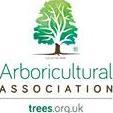
Article by Ed Baker, Planner (Tree Officer), City of Cardiff Council
The soil is a dark, mysterious world. Until we put a spade into it or look at it under a microscope, we can fail to appreciate its complexity and the kaleidoscope of life it supports. It then becomes ‘muck’ or ‘dirt’, to be shifted, sifted and squashed to support development. So long as we tear it up with a big metal claw and add a bit of muck to it, it will grow us big trees without complaint, won’t it?
Often we are told that trees have died because they have had too little or too much water, when the real problem is soil that has been turned into a lifeless, concrete porridge, into which a pampered nursery tree has been dropped and then, to ‘help it out’, surrounded by a quagmire of compost and fertiliser!
For those of us professionally involved in the care and cultivation of amenity trees, failure to get things right from the bottom up is failure full stop. Arboriculture is no different from agriculture in that it begins and ends with the soil.
Many of our towns and cities are developing fast, and soils untouched by ought but a plough since the end of the last ice age face potentially catastrophic damage. Yet with careful assessment and handling, the best of these soils can be protected so that they support the growth of large trees, giving back to the soil what centuries of farming and more recent development have taken out.
To ensure that the best soils are protected and re-used appropriately, they should be professionally assessed by a soil scientist in accordance with the 2009 Defra ‘Construction Code of Practice for the Sustainable Use of Soils on Construction Sites’. This results in a Soil Resource Survey (SRS) and Soil Resource Plan (SRP) that should inform landscaping specifications and construction environmental management plans. In the same way that an arboriculturist should oversee tree protection on a development site, a soil scientist should oversee soil handling, storage, amelioration and placement, in accordance with the SRP.
Leaving soil handling to groundworks or geotechnical contractors alone may result in a development that satisfies engineering requirements of the soil, but may be less suitable for supporting the establishment and healthy growth of vegetation, particularly large trees. The consequence could be costly in environmental and financial terms, requiring extensive soil amelioration, soil importation and replacement of planting failures.
Relying on generic soil specifications and compliance with British Standards may result in the widespread use of imported, ‘as dug’ or manufactured, ‘multi-purpose’ soils, even when existing in situ or site-won soils could be equally or more effective at supporting the proposed planting.
Different vegetation types such as wildflower grassland, amenity grassland and large, root-balled trees have differing ‘performance’ requirements of the soil, and generic specifications, or those that meet the relatively broad criteria of the British Standards only, may result in poor performance or failures.
Over-specification of topsoil and underspecification of subsoil are common problems with regard to tree planting, with some considering that large trees require a deep hole full of topsoil, compost and fertiliser to grow successfully. The result of this can be oxygen depletion, excessive settlement, spiralling roots and ‘sump’ conditions, so that planting holes become bogs, with the smells to go with it! Anybody who has dug trenches to expose a soil profile knows that in nature ‘topsoil’ depths typically extend no deeper than 400mm, often much less, yet it is still common to see tree pit sections showing topsoil enveloping root-balls to 600mm depth, ‘enriched’ with composts and fertiliser and surrounded by soil of unknown specification.
Subsoil on the other hand is often ignored, or simply proposed for ‘ripping’, without evidence from a soil scientist that this will be necessary or effective, or a description of the methods and equipment to be used. Particularly where larger trees are being planted, subsoil with optimal qualities of aeration and drainage, including under the loading of a large root-ball, is essential to effective establishment. Ensuring that provision is made in practical and financial terms for effective subsoil handling, amelioration or importation is essential, wherever large tree planting is proposed.
Cardiff Council is preparing guidance on soils and development, but this does not seem to be a widespread approach. It will be a learning process, no doubt subject to refinement over time, but the more local authorities develop this sort of guidance, and share knowledge on best practice and local success stories, the better it will be, not only for soils, but in turn for trees and people.
Should you wish to discuss the draft soils and development guidance that is in preparation, please contact [email protected].
-
 2
2
-
 1
1
Report Article





.thumb.JPG.decb7659f319599e51647fc718faa622.JPG)

.thumb.jpg.939bd575639367873095b8889c800bd2.jpg)




Recommended Comments
There are no comments to display.
Create an account or sign in to comment
You need to be a member in order to leave a comment
Create an account
Sign up for a new account in our community. It's easy!
Register a new accountSign in
Already have an account? Sign in here.
Sign In Now